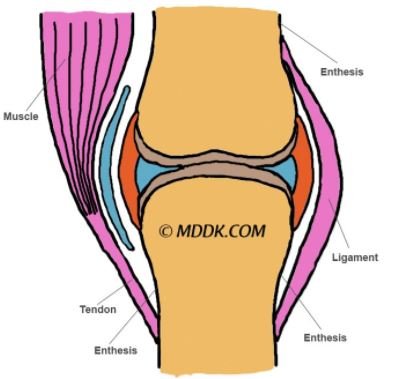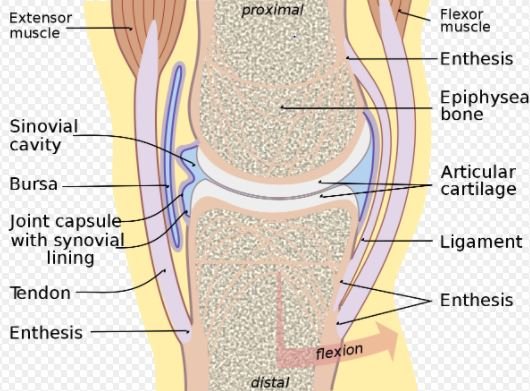What is Enthesopathy?
Entheses are points where tendons and ligaments attach to the bone. Enthesopathy is a condition that affects your entheses. This condition causes your entheses to swell, become inflamed or get irritated. Enthesopathy occurs due to inflammatory conditions or injury to the entheses.
This disorder can occur in several parts of your body such as knees, hips, feet, heels, elbow and shoulder. Enthesopathy is more prevalent in people above the age of 65. Enthesopathy is not a disease itself but describes various diseases that affect your entheses.

Enthesis Anatomy
In the past, the understanding of enthesis has been a confusing chapter. It has long been considered to be the focal tissues attaching to a bone. Now, an evolving aspect about this tissue is that, it’s not just a tissue but an organ. Entheses are part of an organ named as enthesis organ.
In defining an organ, it is a group of tissues functioning together to perform specific tasks. So, enthesis organis are found in regions where ligaments and tendons are attaching to a bone. It is that part which joins these tissues (ligaments and tendons) to the bone.

Causes
There are several diseases that may lead to enthesopathy such as inflammatory conditions.
Spondyloarthropathies
Spondyloarthropathies are chronic diseases affecting your joints. They affect both children and adults. Spondyloarthropathies affects your entheses and sacroiliac joint, these are connections between your spine and pelvic.
The causes of spondyloarthropathies are unknown but genetic factors have been identified as one of the causes of spondyloarthropathies. The following are some of spondyloarthropathies diseases:
Ankylosing Spondylitis
It is a type of disease that belongs to the family of spondyloarthropathies. The disease is chronic and usually affects your spine. Ankylosing spondylitis is characterized by pain, swelling and rigidity and little movement in the lower back, hips, neck, heels and middle back.
In severe circumstances, this disorder may cause joints in your spine to combine. This makes your back stiff and painful.
The cause of this disease is yet to be identified but it has been found to be hereditary. The condition is more common in people below the age of 35 and men are more affected than women.
Reactive arthritis
It’s a type of arthritis disease that affects your joints through inflammation. This disease occurs when your body reacts to bacterial infection.
These bacteria include those found in your genitals such as Chlamydia trachomatis and those in the bowel like Salmonella. These bacteria weaken your immune system and elevate your vulnerability to infections. This condition causes pain and swelling in your toes, fingers, low back, heels and joints particularly those in the knees and ankles.
Psoriatic Arthritis
This is a type of arthritis that affects some people with a skin disorder called psoriasis. Psoriasis is a skin disorder in which your skin forms reddish patches covered with scales.
Psoriatic arthritis occurs when your immune system is hyperactive. The immune system starts to attack and destroy your health tissues and cells. This causes swellings and pain in your joints.
This condition is also hereditary. People with a family history of psoriasis or psoriatic arthritis are high likely to develop this condition. In addition, bacterial infection is also considered to promote psoriatic arthritis.
Psoriatic arthritis can cause your toes and fingers to swell. It can also lead to deformities in your feet and hand even before you experience symptoms of the joints. This condition can also cause your Achilles tendinitis and plantar fasciitis to become painful. Psoriatic arthritis also causes pain in your lower back especially those joints between the spine and pelvic.
Rheumatoid arthritis
This occurs when your body does not have enough nutrients to boost the immune system. As a result your immune system becomes weaker and hence unable to defend the body against infections. This leads to noticeable painful swellings in your knees and ankles.
Other causes of enthesopathy include injuries on your foot like some forms of accident. Staying for longer periods without movement may cause swelling in your elbow, knees and neck.
Symptoms
Despite this condition occurring in different parts of your body, the main symptoms include inflammation, swelling and pain in joints such as hips, elbow, shoulder and foot. This condition also causes your fingers and toes to swell.
Other symptoms include difficulty to walk or move any part of your body. Your shoulder may freeze and makes it difficult to move your neck.

Diagnosis
A person suffering from enthesopathy should discuss the symptoms with the doctor. After your doctor has reviewed your symptoms, a physical test follows. In physical test, your doctor checks for swellings in your. Your doctor can also conduct additional tests such as:
Sedimentation rate test
Your doctor takes a sample of blood and performs a sedimentation test. This test helps your doctor to determine the level of inflammation in your body.
Fluid joint analysis
Your doctor will remove fluids from your joints and analyze it for inflammation and infection10.
Imaging tests
Your doctor can use imaging tests to detect any abnormalities in your bone and joint. Your doctor can use any of the following imaging tests: X-rays and MRI scan.
Treatment
Treatment for enthesopathy depends on the severity of your symptoms, affected areas and underlying conditions. The following are some ways of treating this condition:
Medicines
Your doctor may recommend medications to relieve swellings, inflammation and pain in your joints. Medicines such as NSAIDs are used to reduce inflammation and ease pain in your joints. Examples of NSAIDs your doctor can prescribe are asprin and ibuprofen.
Other medicines such as corticosteroids are also used to relieve pain and soreness in your joints.
Surgery
If your symptoms are very severe, your doctor may suggest surgery to treat inflammation and relieve pain in your joints. Depending on the area affected, the patient may undergo orthopedic surgery, neurosurgery and spine surgery.
Exercises
Lifestyle changes may be recommended by your doctor if overuse of a physical activity is responsible for enthesopathy. Your doctor may recommend that you minimize doing a particular activity to prevent aggravating inflammation and pain in your joints.
In case your exercise activities are exerting pressure on your joints, your doctor will assist you come up with an exercise plan to help you exercise without stressing your joints.
Your doctor can recommend stretching or strengthening exercises to help you relieve pain in your joints. You can be recommended to a physio therapist to help you improve movements in your joints.
Home Remedies
You can prevent symptoms of enthesopathy by using the following home remedies:
- Apply ice packs on the affected joints to reduce swellings
- Place hot water bag on the affected place on your ankle, knee to reduce swelling and pain
- Perform very light stretching exercises regularly on your leg and hand to reduce stiffness.
Reference List
- Enthesopathy. https://www.epainassist.com/muscles-and-tendons/what-is-inflammation-of-ligaments-or-enthesopathy-and-how-is-it-treated
- Enthesopathy. http://orthomedctr.com/enthesopathy.php
- Enthesopathy. http://www.mdguidelines.com/enthesopathy
- Enthesitis and Enthesopathy. http://enthesis.info/about.html
- Enthesopathy. http://www.healthline.com/health/enthesopathy#treatment7
- Psoriatic arthritis. http://www.mayoclinic.org/diseases-conditions/psoriatic-arthritis/symptoms-causes/dxc-20233899
- Reactive arthritis. http://www.rheumatology.org/I-Am-A/Patient-Caregiver/Diseases-Conditions/Reactive-Arthritis
- Spondyloarthropathies. http://www.webmd.com/arthritis/tc/spondyloarthropathies-topic-overview#1
- Sedimentation rate. http://www.mayoclinic.org/tests-procedures/sed-rate/home/ovc-20207006
- Joint fluid analysis test. http://www.webmd.com/arthritis/joint-fluid-analysis#1

To determine internal swelling is difficult enough, therefore, consequently, they influence the body for a long time, which threatens the normal fetus. Fluids are dangerous because they break blood circulation. Similar picture leads to worsening feeding and the breath baby, formed hypoxia.
Fighting such a pathology should be done with the help of correction feeding and special procedures so that water does not stay tissues. If expectant mother is resting, then under the feet preferably put a cushion or pillow to improve the blood circulation of tired legs. Prohibited long time to sit or stand, as this leads to stagnation in the body. It is recommended that the knee-elbow position several times a day in order to increase blood flow.
swollen feet and legs during pregnancy